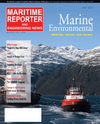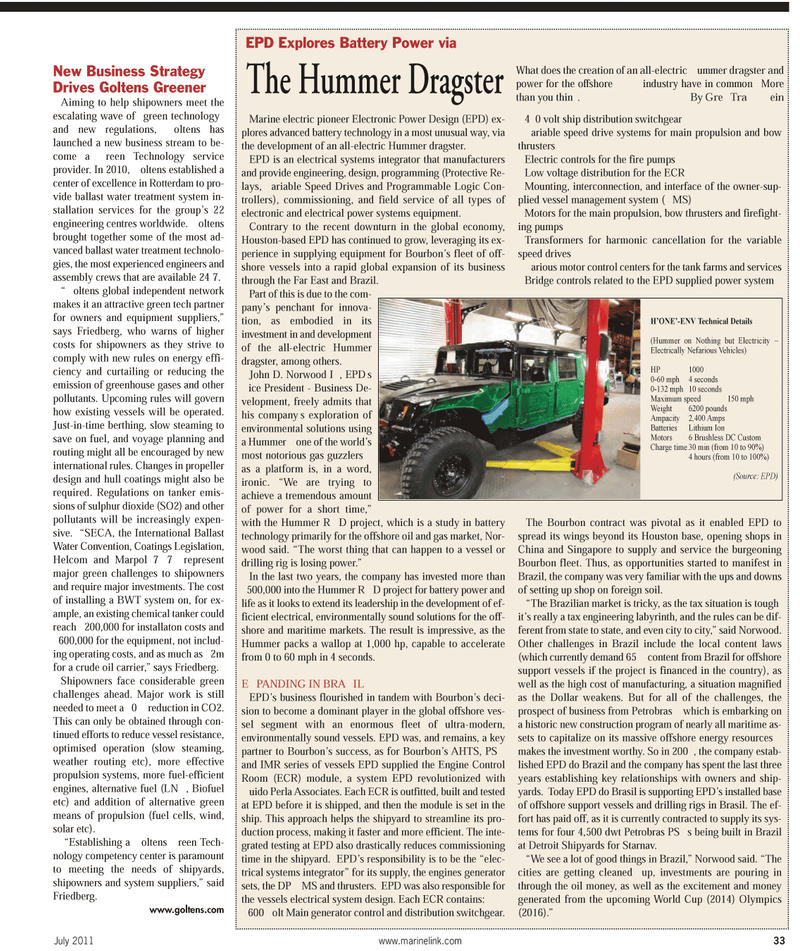
Page 33: of Maritime Reporter Magazine (July 2011)
The Green Ship Edition
Read this page in Pdf, Flash or Html5 edition of July 2011 Maritime Reporter Magazine
July 2011www.marinelink.com 33What does the creation of an all-electric ummer dragster and power for the offshore industry have in common More than you thin. By Gre Traein EPD Explores Battery Power via The Hummer Dragster Marine electric pioneer Electronic Power Design (EPD) ex- plores advanced battery technology in a most unusual way, via the development of an all-electric Hummer dragster. EPD is an electrical systems integrator that manufacturers and provide engineering, design, programming (Protective Re- lays, ariable Speed Drives and Programmable Logic Con- trollers), commissioning, and field service of all types of electronic and electrical power systemsequipment. Contrary to the recent downturn in the global economy, Houston-based EPD has continued to grow, leveraging its ex- perience in supplying equipment for Bourbon?s fleet of off- shore vessels into a rapid global expansion of its business through the Far East and Brazil. Part of this is due to the com- pany?s penchant for innova- tion, as embodied in itsinvestment in and development of the all-electric Hummerdragster, among others. John D. Norwood I, EPDs ice President - Business De-velopment, freely admits that his companys exploration of environmental solutions using a Hummer one of the world?s most notorious gas guzzlers as a platform is, in a word, ironic. ?We are trying to achieve a tremendous amount of power for a short time,? with the Hummer RD project, which is a study in battery technology primarily for the offshore oil and gas market, Nor- wood said. ?The worst thing that can happen to a vessel or drilling rig is losing power.? In the last two years, the company has invested more than 500,000 into the Hummer RD project for battery power and life as it looks to extend its leadership in the development of ef- ficient electrical, environmentally sound solutions for the off- shore and maritime markets. The result is impressive, as the Hummer packs a wallop at 1,000 hp, capable to accelerate from 0 to 60 mph in 4 seconds.EPANDING IN BRAIL EPD?s business flourished in tandem with Bourbon?s deci- sion to become a dominant player in the global offshore ves- sel segment with an enormous fleet of ultra-modern, environmentally sound vessels. EPD was, and remains, a key partner to Bourbon?s success, as for Bourbon?s AHTS, PS and IMR series of vessels EPD supplied the Engine Control Room (ECR) module, a system EPD revolutionized with uido Perla Associates. Each ECR is outfitted, built and tested at EPD before it is shipped, and then the module is set in theship. This approach helps the shipyard to streamline its pro- duction process, making it faster and more efficient. The inte- grated testing at EPD also drastically reduces commissioningtime in the shipyard. EPD?s responsibility is to be the ?elec- trical systems integrator? for its supply, the enginesgenerator sets, the DPMS and thrusters. EPD was also responsible for the vessels electrical system design. Each ECR contains: 600 olt Main generator control and distribution switchgear. 40 volt ship distribution switchgear ariable speed drive systems for main propulsion and bow thrustersElectric controls for the fire pumps Low voltage distribution for the ECR Mounting, interconnection, and interface of the owner-sup- plied vessel management system (MS) Motors for the main propulsion, bow thrusters and firefight- ing pumpsTransformers for harmonic cancellation for the variable speed drives arious motor control centers for the tank farms and services Bridge controls related to the EPD supplied power system The Bourbon contract was pivotal as it enabled EPD to spread its wings beyond its Houston base, opening shops in China and Singapore to supply and service the burgeoning Bourbon fleet. Thus, as opportunities started to manifest in Brazil, the company was very familiar with the ups and downs of setting up shop on foreign soil.?The Brazilian market is tricky, as the tax situation is tough it?s really a tax engineering labyrinth, and the rules can be dif- ferent from state to state, and even city to city,? said Norwood. Other challenges in Brazil include the local content laws (which currently demand 65 content from Brazil for offshore support vessels if the project is financed in the country), as well as the high cost of manufacturing, a situation magnified as the Dollar weakens. But for all of the challenges, the prospect of business from Petrobras which is embarking on a historic new construction program of nearly all maritime as- sets to capitalize on its massive offshore energy resources makes the investment worthy. So in 200, the company estab- lished EPD do Brazil and the company has spent the last three years establishing key relationships with owners and ship- yards. Today EPD do Brasil is supporting EPD?s installed base of offshore support vessels and drilling rigs in Brasil. The ef- fort has paid off, as it is currently contracted to supply its sys- tems for four 4,500 dwt Petrobras PSs being built in Brazil at Detroit Shipyards for Starnav. ?We see a lot of good things in Brazil,? Norwood said. ?The cities are getting cleaned up, investments are pouring in through the oil money, as well as the excitement and money generated from the upcoming World Cup (2014) Olympics (2016).? H?ONE?-ENV Technical Details (Hummer on Nothing but Electricity ? Electrically Nefarious Vehicles) HP1000 0-60 mph4 seconds 0-132 mph10 seconds Maximum speed150 mph Weight6200 pounds Ampacity2,400 Amps BatteriesLithium Ion Motors6 Brushless DC Custom Charge time30 min (from 10 to 90%) 4 hours (from 10 to 100%)(Source: EPD) New Business StrategyDrives Goltens Greener Aiming to help shipowners meet the escalating wave of green technology and new regulations, oltens has launched a new business stream to be- come a reen Technology service provider. In 2010, oltens established a center of excellence in Rotterdam to pro- vide ballast water treatment system in- stallation services for the group?s 22 engineering centres worldwide. oltens brought together some of the most ad-vanced ballast water treatment technolo- gies, the most experienced engineers and assembly crews that are available 247. ?oltens global independent network makes it an attractive green tech partner for owners and equipment suppliers,? says Friedberg, who warns of higher costs for shipowners as they strive to comply with new rules on energy effi- ciency and curtailing or reducing the emission of greenhouse gases and otherpollutants. Upcoming rules will govern how existing vessels will be operated. Just-in-time berthing, slow steaming to save on fuel, and voyage planning and routing might all be encouraged by new international rules. Changes in propellerdesign and hull coatings might also berequired. Regulations on tanker emis- sions of sulphur dioxide (SO2) and otherpollutants will be increasingly expen- sive. ?SECA, the International Ballast Water Convention, Coatings Legislation, Helcom and Marpol 77 represent major green challenges to shipowners and require major investments. The cost of installing a BWT system on, for ex- ample, an existing chemical tanker could reach 200,000 for installaton costs and 600,000 for the equipment, not includ-ing operating costs, and as much as 2m for a crude oil carrier,? says Friedberg. Shipowners face considerable green challenges ahead. Major work is still needed to meet a 0 reduction in CO2. This can only be obtained through con-tinued efforts to reduce vessel resistance, optimised operation (slow steaming, weather routing etc), more effective propulsion systems, more fuel-efficient engines, alternative fuel (LN, Biofuel etc) and addition of alternative green means of propulsion (fuel cells, wind,solar etc). ?Establishing a oltens reen Tech- nology competency center is paramount to meeting the needs of shipyards, shipowners and system suppliers,? said Friedberg. www.goltens.com

 32
32

 34
34
